Gas cleaning system and method
a cleaning system and gas technology, applied in the direction of combustible gas purification/modification, energy input, synthetic resin layered products, etc., can solve the problems of high cost of disposal of cleaning process byproducts, high contamination of water, and large amount of treatmen
- Summary
- Abstract
- Description
- Claims
- Application Information
AI Technical Summary
Benefits of technology
Problems solved by technology
Method used
Image
Examples
Embodiment Construction
[0025]As shown in FIGS. 1–3, this invention is directed to systems and methods for cleaning feedstock gas, such as syngas or other gases. Syngas may be defined as any gas produced through gasification of a biomass, such as, but not limited to, coal, oil and natural gas, by the application of high temperature and steam. In particular, in at least one embodiment, the systems and methods may reduce concentrations of halides, sulfur, particulate, and mercury contained in the feedstock gas to levels at or below governing guidelines. Feedstock gas may be produced for a variety of applications, such as, but not limited to: synthesis of chemicals, such as, but not limited to, methanol, ammonia, and hydrogen; fuel cell power generation; IGCC power generation; and the like.
[0026]As shown in FIGS. 1–3, the gas cleaning system 10 may include a plurality of filter vessels 12 for removing one or more of the constituents previously mentioned or others from feedstock gas. The filter vessels 12 may ...
PUM
| Property | Measurement | Unit |
|---|---|---|
| temperature | aaaaa | aaaaa |
| temperature | aaaaa | aaaaa |
| temperature | aaaaa | aaaaa |
Abstract
Description
Claims
Application Information
 Login to View More
Login to View More - R&D
- Intellectual Property
- Life Sciences
- Materials
- Tech Scout
- Unparalleled Data Quality
- Higher Quality Content
- 60% Fewer Hallucinations
Browse by: Latest US Patents, China's latest patents, Technical Efficacy Thesaurus, Application Domain, Technology Topic, Popular Technical Reports.
© 2025 PatSnap. All rights reserved.Legal|Privacy policy|Modern Slavery Act Transparency Statement|Sitemap|About US| Contact US: help@patsnap.com



